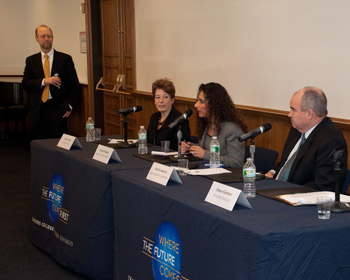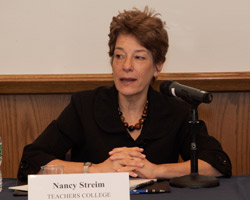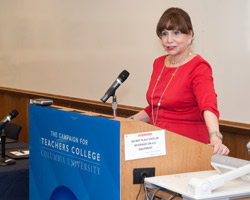TC Presentation Underscores the Value of University-Assisted K-12 Schools
By Patricia Lamiell
“I think it’s imperative that more schools of education work in strategic ways with their local schools to bring the best of what we know to improve schools through the university-assisted model. I think it’s one of the most important contributions a university today can make to future generations.”
Addressing the annual meeting of the International Association of Laboratory Schools at Teachers College on April 3, TC President Susan Fuhrman urged other higher education institutions to follow the College’s example, arguing that schools like the Teachers College Community School can transform public education if they are created and run as true partnerships among the universities, the school systems and the communities they serve.
Fuhrman added that universities and education schools “are uniquely positioned” to leverage leading-edge research and “rich, interdisciplinary resources from across the university” in providing high-quality education to children in their communities. In addition to founding TCCS in 2011, the College, supported by JPMorgan Chase Foundation, has also created REACH (Raising Educational Achievement Coalition of Harlem), a network of six TC-assisted local public schools. REACH is administered by the Office of School and Community Partnerships (OSCP) at Teachers College, which is led by Associate Vice President Nancy Streim, who is also Special Advisor to the Columbia University Provost.
The Teachers College Community School is modeled on an award-winning public school that Fuhrman and Streim spearheaded in West Philadelphia when Fuhrman was Dean of the School of Education at the University of Pennsylvania. In New York City, they forged partnerships with the New York City Department of Education, West Harlem Development Corporation and Community Board 9 in establishing the Teachers College Community School in Harlem. It is intended to demonstrate the importance of comprehensive school-based supports for children and families in the neighborhoods of their partner universities, which Fuhrman said is an important factor in the model’s success. At TCCS, the university assists with curriculum and teaching, provides enrichment activities during and after school, and addresses children’s physical and mental health needs.
“If we have schools that need help in our neighborhood, and we have promising, research-based solutions, then, I think we, as educators, truly have a moral obligation to do what we can to improve the situation.”
Following Fuhrman’s keynote address, Jim Gardner, TC’s Associate Vice President of External Affairs, moderated a panel discussion among Streim and two higher educaiton leaders who have been instrumental in creating and running public K-12 schools in their communities: David W. Andrews, Dean and Professor in the School of Education at Johns Hopkins University, who initiated the Henderson-Hopkins School in East Baltimore; and Beatriz Rendón, Associate Vice President of Educational Outreach and Student Services at Arizona State University and Chief Executive Officer of ASU Preparatory Academy, a charter school with locations in Phoenix and Mesa. Each panelist described a different model for creating and running a university-assisted public community school.
The mission of ASU Preparatory is to make college accessible to families in the surrounding community, Rendón said. The academic expectations are high, and students advance to higher grades only as they become proficient in concepts taught at their grade level. Rendón said several factors have led to the school’s success, including:
• The expectation that every graduate will have the opportunity to go to college;
• High expectations for parental involvement and participation: parents are required to put in 30 hours of volunteer time per year;
• The use of supplemental resources from the university and other public institutions, and from private businesses and philanthropies.
The Henderson-Hopkins School, housed in a new $53 million, state-of-the-art, multipurpose educational facility, was created primarily to help improve the blighted neighborhood around Johns Hopkins Medical School in East Baltimore, Andrews said. While the East Baltimore Development Inc. renewal project demolished more than 200 mostly abandoned row houses to make way for the new elementary school and new townhouses, gentrification is not part of the plan, he said. The campus includes subsidized day care, and its library, gym, auditorium and athletics fields are “accessible, by design, at any time the community wants to use them,” Andrews said.
“We built a shiny penny in a very difficult neighborhood,” Andrews said. “We overbuilt on purpose and put the Hopkins name on it,” in order to signal that the university was committed to building and nurturing a mixed-income community and staying there, and the housing component was critical. “We said, ‘if you want to go to this school, you have to move into the neighborhood,’ ” said Andrews, who lives there himself.
Drawing students by lottery from the diverse neighborhoods of Harlem was a high priority in the creation of the Teachers College Community School, Streim said. TCCS also needed to be close to the Columbia and Teachers College campuses so that the children, their families and university students could come and go easily.
Though the models differ, certain features appear in all three. In all three settings, the university president stands behind the initiative. Like Arizona Prep, TCCS needed to build trust and accountability with neighborhood residents, especially parents, she said, whose sweat equity and support of their children’s education have been essential to the school’s success. TCCS and Henderson Hopkins both integrate university expertise and resources in the fields of education, health and psychology.
Creating a school like TCCS “involves making sure you’ve got a commitment from the higher education institution and the community, and it’s a long-term effort,” Streim said. “It can take a number of years to develop, but the outcomes are stronger for it.”
Streim said TC wanted a community school that shows how it’s possible to build a high-quality traditional public school that could be replicated by universities in other neighborhoods in New York City and across the country. Asked why TC didn’t open a charter school, Streim responded, “For us to be involved in public education, we wanted to jump in feet-first” with the local school system. “After all, public schools educate 90 percent of the children in our country.” She added that TC found “more flexibility in the public system than one might expect.”
Published Tuesday, Apr. 22, 2014


